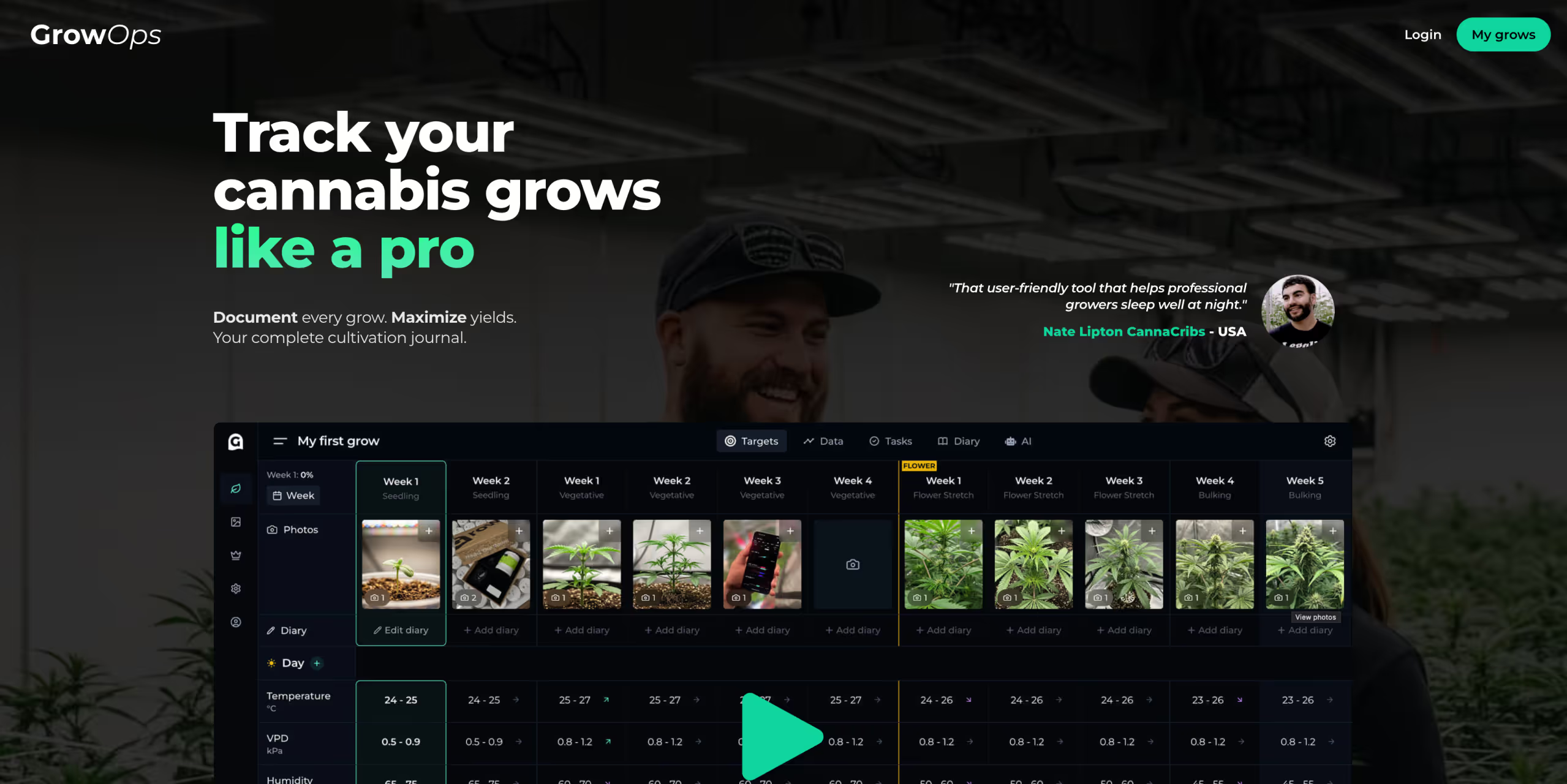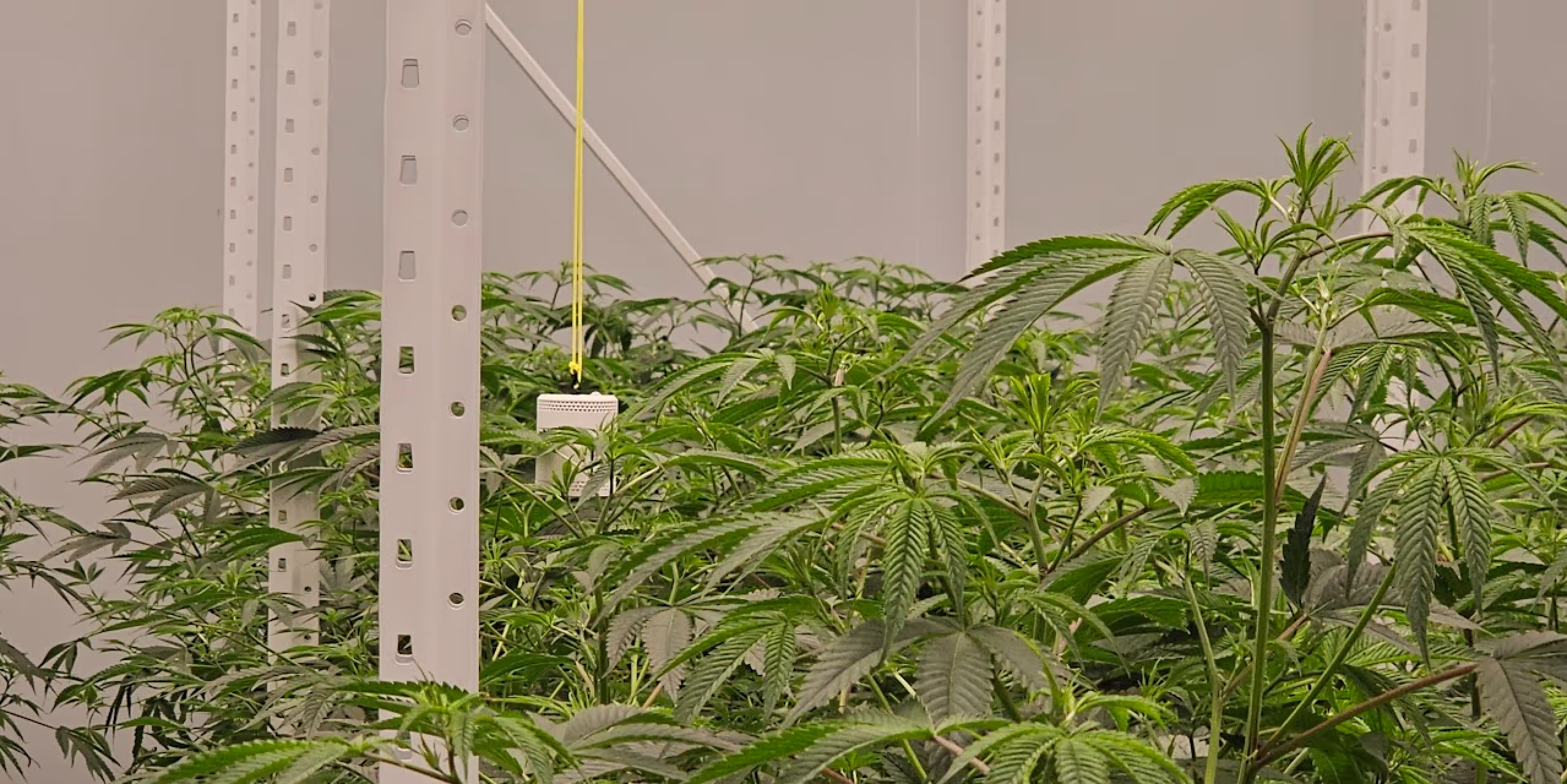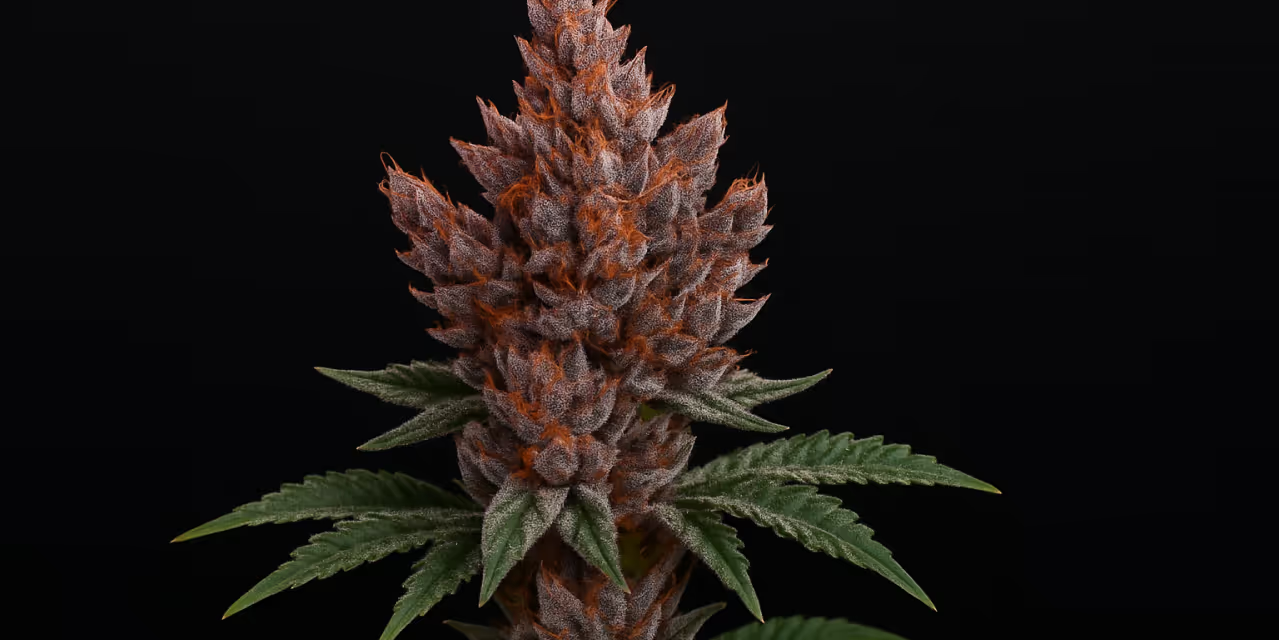Dial in your indoor grow: The best VPD for flowering


Welcome back to our VPD mini-series! We've been exploring the role of Vapour Pressure Deficit (VPD) across various growth stages for optimal plant growth.
We’ve already delved deep into the optimal VPD settings for seedlings and the vegetative stage. Now, we turn our focus to the critical flowering stage, where the magic truly happens.
Flowering is when your plants put all their energy into producing buds. This makes it a crucial period that demands precision and care.
In this final instalment, we'll uncover the secrets to optimising your indoor grow setup for the best VPD during flowering.
Achieving the perfect VPD is about more than just hitting the right numbers. It's about understanding your plants' unique needs during this transformative phase. Then using that knowledge to create an environment where they can thrive and produce a top-quality harvest.
So, whether you're a seasoned grower or a green-thumbed enthusiast stepping into the flowering phase for the first time, this post is your comprehensive guide to getting the VPD right, ensuring your plants reach their full potential.
Disclaimer: Any information given on this site is for educational purposes only. Please ensure if you’re growing cannabis, you’re doing so in accordance with the law and subject to appropriate permissions and licenses of the applicable country.
Understanding VPD for flowering stage
A deep understanding of Vapour Pressure Deficit (VPD) is at the heart of every thriving indoor grow, especially during flowering.
But what exactly is VPD, and why does it become even more crucial when your plants begin to flower?
Vapour pressure deficit explained
In simple terms, VPD measures the difference between the amount of moisture in the air and the maximum amount of moisture the air can hold when it's fully saturated.
This delicate balance directly influences your plants' ability to transpire and release water vapour from their leaves into the air.
During flowering, optimal transpiration is critical to healthy bud development. This is because it affects nutrient uptake, plant growth and overall health.
Diving in a bit deeper understanding how much moisture your cannabis plants need involves grasping concepts like saturation vapour pressure, which is key to managing water vapour present in your grow space.
By learning to calculate vapour pressure deficit, you gain insights into your plants' transpiration needs, ensuring they receive just the right amount of irrigation water.

The significance of VPD in flowering for plant transpiration
As your cannabis plants transition from the early veg stage to flowering, their needs change dramatically.
The ideal VPD for flowering ensures that your plants can transpire effectively, promoting robust bud growth. Optimal environmental conditions also minimise the risk of excessive transpiration, stress, disease, and environmental imbalances.
It's about creating the perfect conditions for your flowers to develop fully, packed with aroma, potency, and visual appeal.
Adjusting for flowering needs
Achieving the optimal VPD for flowering isn't a one-size-fits-all scenario. Factors such as strain characteristics and grow room conditions can influence the ideal VPD settings.
You need to tailor your environment to support the unique needs of your plants as you flip from the vegetative stage, and they put all their energy into producing flowers.
By mastering VPD during the flowering, you're setting the stage for a bountiful harvest that reflects the time, care, and attention you've invested in your grow.
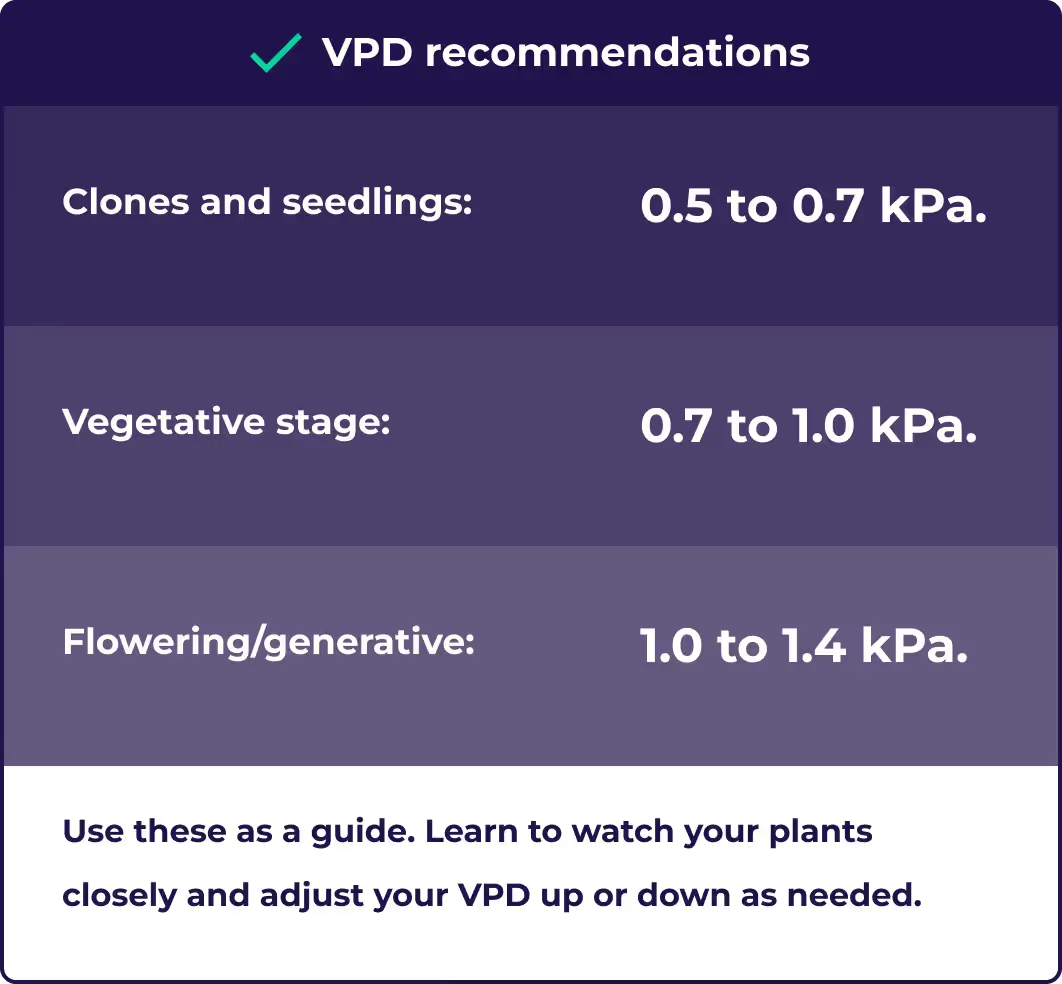
VPD for flowering cannabis
When it comes to flowering, the stakes are high, and the margin for error is slim. This is when your plants are most vulnerable yet poised for peak performance.
Understanding and maintaining the ideal vapour pressure deficit can significantly impact the quality and quantity of your harvest.
The optimum VPD for flowering cannabis typically falls between 1.0 to 1.4 kPa (kilopascals).
This range encourages an optimal transpiration rate, leading to efficient nutrient uptake and robust bud development.
As a general rule of thumb, a grower starts at the lower end of the ideal VPD at the start of flower and then moves up to the higher end week on week as flowering progresses.
Why this range matters
In the flowering stage, your plants are less tolerant of environmental stress. A VPD that's too low can lead to overly humid conditions, increasing the risk of mould and bud rot, particularly in dense buds.
On the other hand, a VPD that's too high can stress your plants, leading to poor bud development and reduced resin production.
The ideal VPD range for flowering strikes a balance, providing an environment that supports vigorous bud growth without pushing your plants into very high-stress territory.
Strain-specific considerations
Some cannabis strains may prefer slightly different vapour pressure deficit ranges during flowering, particularly if they're adapted to unique climates.
Strains originating from humid tropical regions might tolerate a slightly lower VPD, while those from arid climates may thrive in a somewhat higher range.
Tailoring the VPD to your strain's natural habitat can further dial in your growing environment for maximum plant growth and flowering performance.
Achieving and maintaining the ideal VPD for flowering requires carefully monitoring and adjusting your ambient room temperature and humidity levels.

How to achieve the ideal VPD for flowering
Navigating the VPD during flowering is a fine art, a mix of science and intuition. Here's how you can dial in the perfect conditions for your flowering plants once you flip from the vegetative stage to early flower:
1. Monitor your grow room environment
The first step is to understand your current grow room conditions clearly. Use digital hygrometers, thermometers an infrared thermometer, or specialist grow room monitors to closely monitor the temperature and relative humidity.
Monitoring daytime VPD is essential as temperatures rise, increasing the drying power of the air around your plants. This can lead to rapid moisture loss; you may need to adjust your irrigation to compensate.
Tracking VPD helps ensure your plants remain hydrated and healthy throughout their growth cycles.
2. Adjust temperature and relative humidity
Based on your readings, you'll need to adjust your temperature and humidity setpoints to move into the ideal VPD for flowering.
This might mean slightly increasing your grow room temperature or using dehumidifiers for humidity control and lowering the humidity. Remember, achieving a VPD ranges 1.0 to 1.4 kPa is the goal.
Increasing temperature
If your VPD is too low, gently increasing air temperature can help. This might involve adjusting your heating system or changing the lighting schedule to add more warmth during the lights-on period.
Controlling humidity
To lower humidity, use dehumidifiers or improve ventilation. Sometimes, simply increasing the airflow with oscillating fans can help maintain the right moisture levels in the air.
3. Use a VPD chart for flowering to boost plant growth
A flowering VPD chart can be an invaluable tool. It helps you visualise the relationship between different temperatures and humidities, guiding you to adjust your grow room conditions to hit the ideal VPD.
Keep our VPD chart for flowering cannabis plants handy and refer to it frequently as you make adjustments. Learn how to calculate VPD here.
4. Fine-tune based on plant response
Plants are the best indicators of whether your vapour pressure deficit adjustments are working. Observe yours closely for signs of plant stress or discomfort, such as leaf curl, (indicating too high VPD) or mould growth (signalling too low VPD).
Adjust your environment accordingly, always aiming for a consistent vapour pressure deficit in the sweet spot where your plants seem happiest.
5. Consider stage-specific needs
As your plants progress through flowering, their tolerance and needs might shift slightly.
Pay attention to these changes and be ready to adjust your VPD settings accordingly. Especially as you approach late flower when buds are becoming more dense, and moisture management becomes even more critical.
Achieving the right VPD for flowering is an ongoing process of monitoring, adjusting, and responding to your plants' needs.
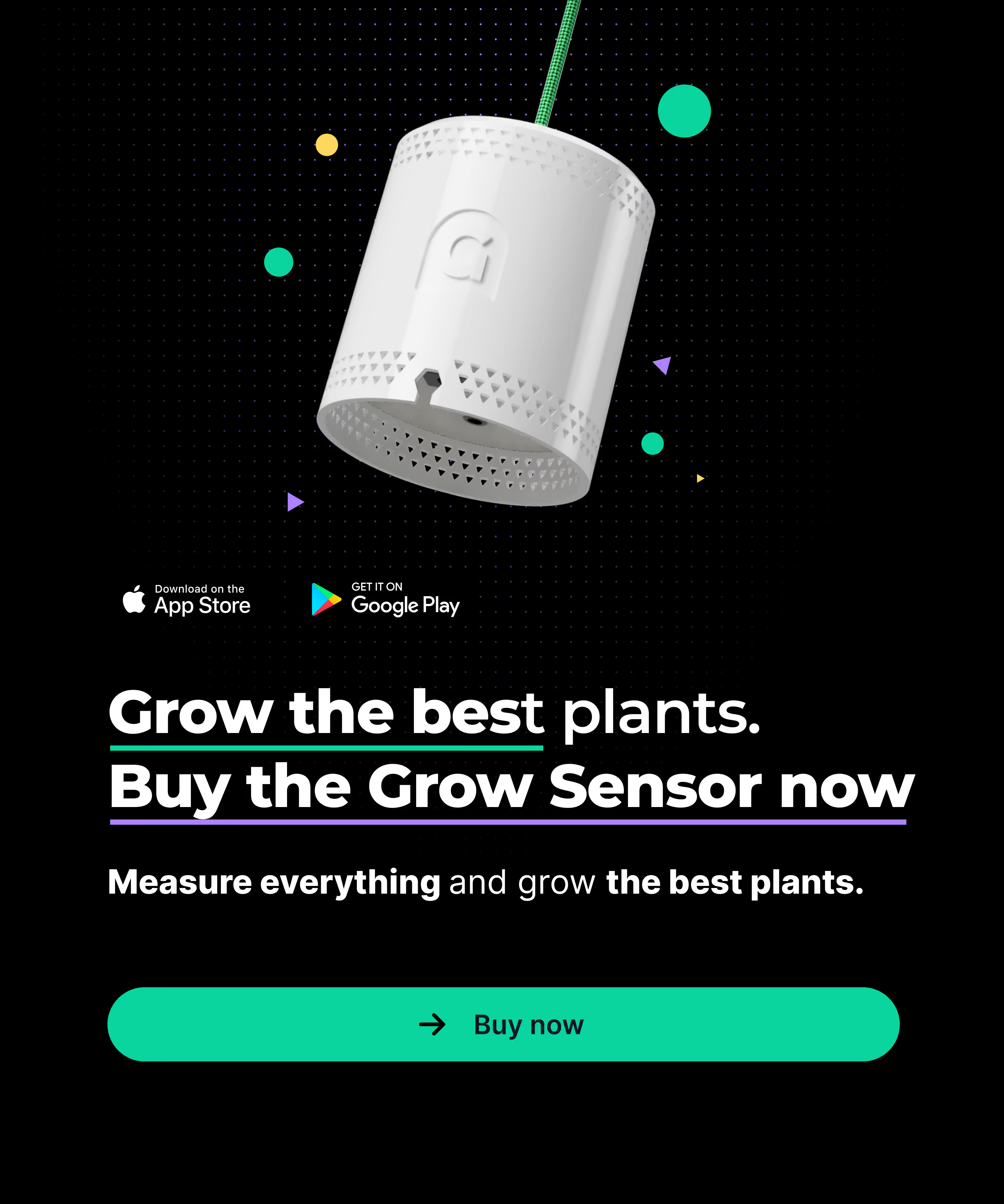
Optimising leaf surface temperatures for VPD during flowering
During flowering, maintaining ideal leaf surface temperatures is another way of optimising VPD. If you take leaf temperature measurements, you’ll work with leaf VPD.
Maintaining optimal leaf VPD ensures efficient transpiration and nutrient uptake, which is critical for healthy bud development. Leaf temps, influenced by light intensity and ambient conditions, should be monitored to adjust environmental controls.
This precision ensures the leaf's surface is neither hot nor cold, promoting optimal photosynthesis and preventing stress.
By fine-tuning your grow room's climate to maintain these temperatures, you create the perfect conditions for flowering, leading to enhanced yields and plant health.

Challenges and solutions for maintaining ideal flowering VPD
Achieving the perfect VPD for the flowering phase is a delicate balance. Growers often encounter challenges that can disrupt this balance, impacting plant health and yield. Here are some common hurdles and how to overcome them:
Challenge 1: High humidity and bud rot
We’ve all been there! Dense buds can trap moisture during flowering, especially in the late stages, leading to high humidity within the canopy. This environment is ripe for bud rot and other fungal diseases.
Solution:
- Increase air circulation around the buds using oscillating fans and ensure good ventilation in the grow room.
- Consider defoliating some of the larger fan leaves to improve airflow around the buds.
- Use a dehumidifier to lower ambient humidity.
Challenge 2: Overly low humidity and slow bud development
Low humidity can accelerate plant transpiration. Plants with a higher-than-ideal transpiration rate lose water faster than they can take up essential nutrients, stressing them and slowing down bud development.
Solution:
- Use a humidifier to gently raise the grow room's relative humidity levels for a higher relative humidity.
- Ensure your watering schedule is adequate to meet your plants' increased demands during flowering.
- Make sure your not overfeeding your plants if they are drinking lots of nutrients.
- Implement a slight decrease in grow room temperature to reduce the transpiration rate.
Challenge 3: Temperature fluctuations
Significant temperature variations between day and night or due to external weather conditions can make it hard to maintain a steady VPD.
Solution:
- Insulate your grow room to protect against external temperature changes.
- Implement heating or cooling systems (like air conditioning) that can quickly respond to temperature fluctuations.
- Use a climate controller to automate temperature adjustments.
Challenge 4: Strain-specific VPD requirements
Some strains have unique VPD preferences based on their genetic origins, which may not align perfectly with general VPD guidelines.
Solution:
- Research your specific strain to understand its natural habitat and adjust your VPD settings accordingly.
- Start with the recommended VPD range and observe your plants' responses, making minor adjustments as needed.
- Connect with other growers with experience with your strain and can offer firsthand advice on the ideal VPD settings.
- Experiment! Try around with higher or lower VPD and measure the results.
Challenge 5: Carbon dioxide and light intensity considerations
Dialling in the perfect VPD is only part of the story. Optimal growth relies on CO2 availability and appropriate light intensity. Both are vital for photosynthesis and plant development. So, maintaining consistent temperature and CO2 levels enhances flowering plants' ability to utilise light efficiently.
Solution:
- Introduce a CO2 supplementation system to boost carbon dioxide levels, especially during peak photosynthetic periods. This enhances plant growth and flowering when combined with optimal VPD and temperature settings.
- Use adjustable LED grow lights to regulate light intensity based on growth stages. Increase intensity during flowering, ensuring it doesn't excessively raise leaf temperatures, thus maintaining a VPD balance.
- Implement a daily monitoring routine using environmental sensors like the Grow Sensor. Analyse data to make informed decisions, ensuring plants' photosynthetic needs are met without exceeding optimal environmental thresholds.
Maintaining the ideal VPD during flowering requires vigilance, adaptability, and a willingness to respond to your plants' needs.
By staying attuned to environmental conditions and plant health, you can navigate these challenges and support your plants in achieving their full potential.
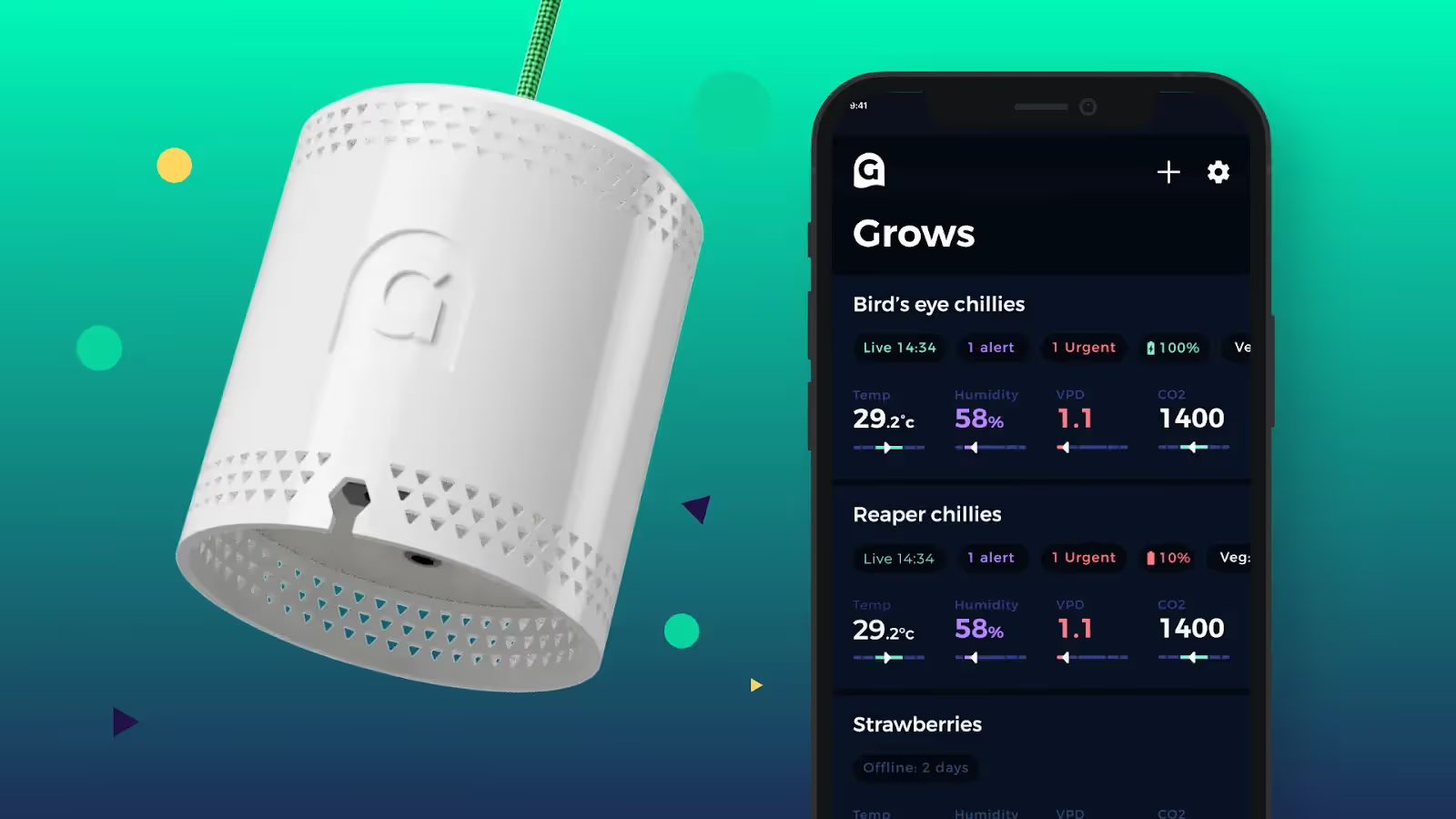
Get the Grow Sensor for optimal VPD management
Navigating the world of growing indoors demands precision, especially when maintaining the ideal VPD levels for your plants.
Whether you're a newcomer to the grow scene or a seasoned cultivator looking to upgrade your setup, understanding and controlling your grow environment is key to thriving plants.
If you're ready to delve deeper into the nuances of indoor growing and truly optimise your plants' potential, the Grow Sensor stands out as a game-changer.
This advanced technology is designed to revolutionise how you monitor and adjust your grow space, ensuring your plants flourish under the best possible conditions.
Placed at the canopy level, it gives you a detailed view of the conditions your plants are experiencing.
From temperature and relative humidity to more sophisticated measurements like VPD, the Grow Sensor has got you covered. Its standout features include:
- Real-time environmental tracking: Stay updated with live data on your grow room's conditions, accessible remotely via apps or desktop software. This means you can adjust your settings on the go, keeping your environment perfectly tuned for your plants. Save the need to caculate calculate vapour pressure deficit manually!
- Advanced sensor technology: The Grow Sensor goes beyond the basics, offering integrated CO2 measurement, leaf temperature sensing and direct leaf VPD calculations, the Grow Sensor ensures you have all the information you need to make informed adjustments.
- Light-level insights: With capabilities like continuous light monitoring with PPFD and full-spectrum PAR sensors, and even Daily Light Integral (DLI) tracking.
- Soil and dew point monitoring: Optional soil probes provide data on Electrical Conductivity (EC), moisture, and temperature, while dew point tracking helps you prevent unwanted moisture levels.
- Versatile connectivity and alerts: The device boasts long-range Wi-Fi connectivity, offline data logging, and customisable alerts through a user-friendly app, ensuring you're always in the loop.
By incorporating the Grow Sensor into your setup, you're actively creating the ideal conditions for your plants to thrive. Its precision and range of features make it an invaluable tool for any grower serious about their cultivation success.
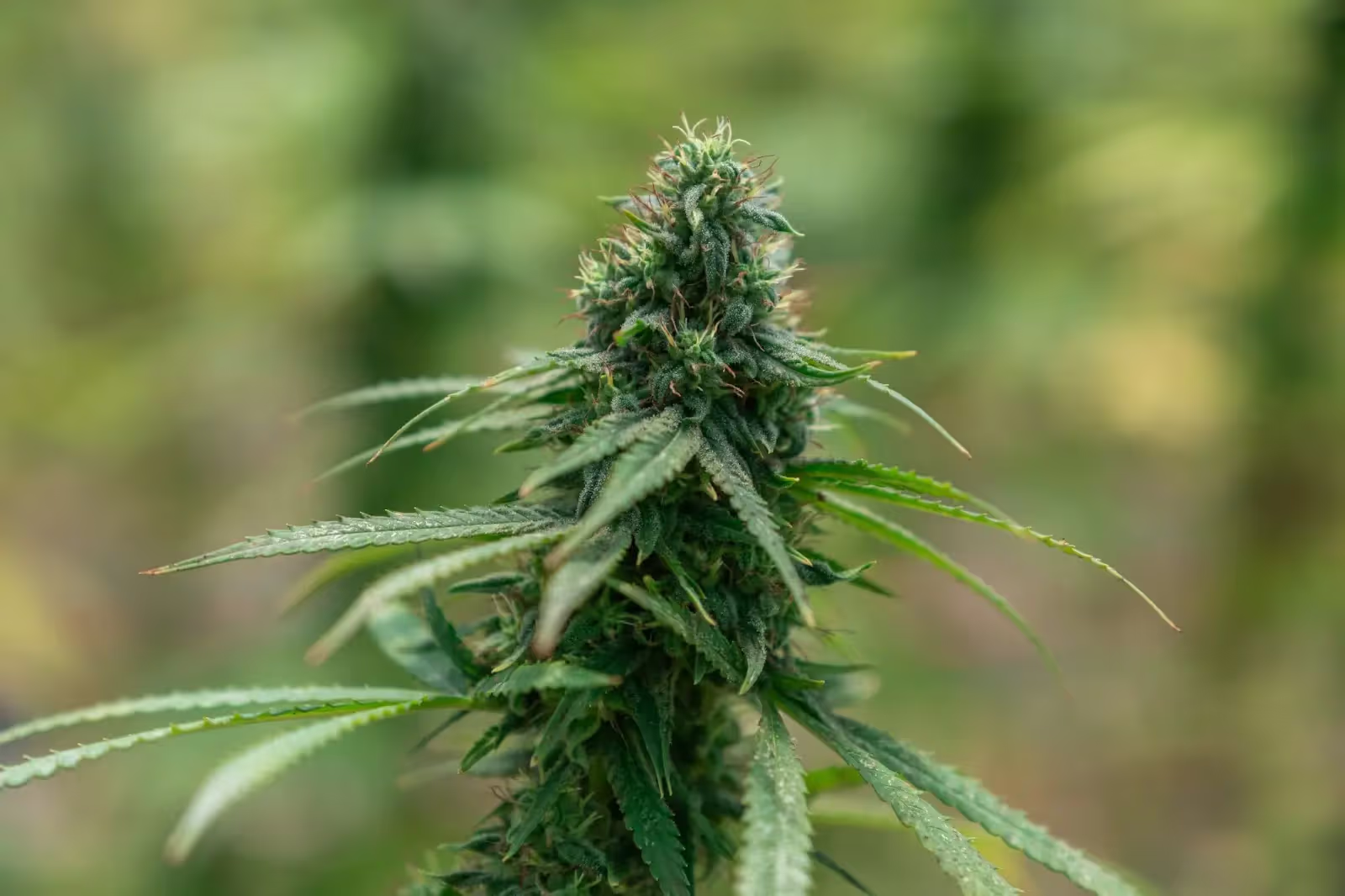
Takeaways:
As we conclude our journey through the vital role of VPD cannabis cultivation, it's clear that optimising VPD during flowering is a cornerstone of successful indoor growing.
The flowering phase is a defining period in your plants' lifecycle, where all the hard work and dedication can culminate in a stellar harvest.
The delicate balance of temperature and humidity influences everything from nutrient uptake to the plant's resilience against pests and diseases.
The environment in which your plants' aromatic compounds and cannabinoids are developed directly impacts the quality of your final product.
Remember, the ideal VPD for flowering cannabis is a guide, not a strict rule. Each grow room has its unique conditions, and each strain may respond differently to the same environment.
The true art of growing lies in observing, understanding, and gently guiding your plants through flowering, adjusting VPD as needed to ensure they thrive.
The reward for your attentiveness and care is in the weight of your harvest and the quality and satisfaction that comes from knowing you've created the best conditions for your plants to flourish.
Happy growing!
FAQs
What is the ideal VPD during flowering?
For flowering cannabis, the best VPD range is typically between 1.0 to 1.4 kPa (kilopascals). This range supports optimal transpiration rates, leading to efficient uptake of nutrients and robust bud development, essential for high-quality cannabis cultivation.
What temps are best for flowering?
The ideal temperature range for your grow room during the flowering stage should be between 20°C to 28°C during the day (lights on) and a bit cooler at night (lights off) to mimic natural conditions, which can be around 18°C to 22°C.
What temp is best for flowering with LED?
Aim for a daytime (lights on) temperature range of about 28°C (30°C with co2) at the start of flower and 22°C at the end of flower. At night (lights off), temperatures should be slightly cooler, ideally between 18°C to 22°C, to encourage healthy plant development and potent bud formation.
These temperatures help ensure that your plants can effectively photosynthesise and transpire, leading to optimal growth and flowering under LED lighting.








.avif)
